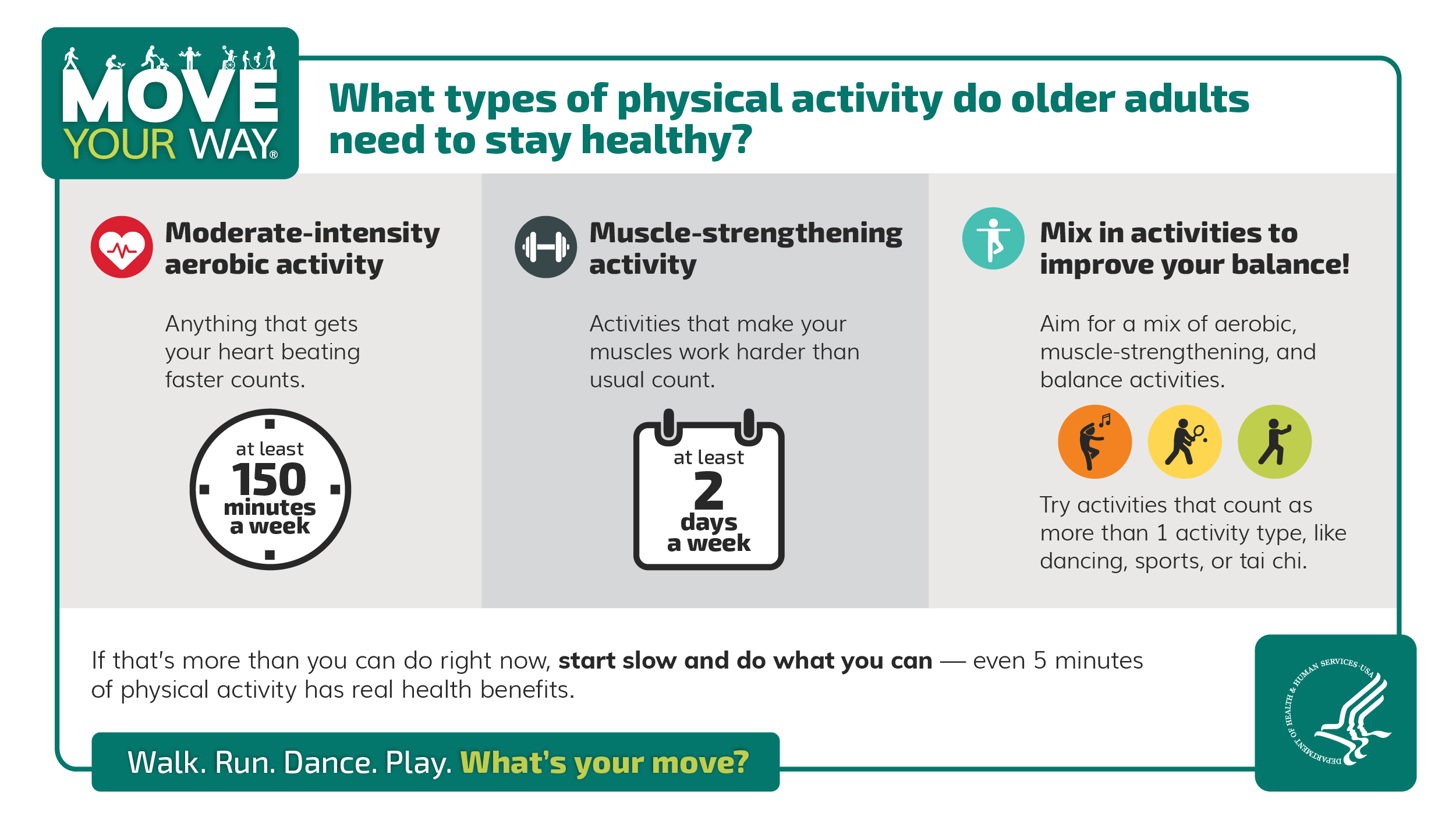- The Midcourse Report provides strategies that professionals working with older adults can use to encourage physical activity. Those professionals include policymakers; exercise and health professionals; health care providers; gerontologists; built environment professionals; and local, state, territorial, and tribal leaders.
- The Midcourse Report doesn’t change the physical activity recommendations outlined in the second edition of the Physical Activity Guidelines for Americans. The graphic below outlines the amount and types of activity the Guidelines recommends for older adults.
Older adults who can’t meet these recommendations — for example, because of chronic health conditions — should be as physically active as they can.
- Physical activity benefits people of all ages — for example, it can help people prevent or manage chronic health conditions like heart disease, high blood pressure, and type 2 diabetes. And physical activity has specific health benefits for older adults. It can help lower their risk of falls, make it less likely they’ll get hurt if they do fall, and help protect against osteoporosis (bone disease) and age-related sarcopenia (loss of muscle mass and strength).
- It’s never too late to start being active and getting the benefits of an active lifestyle! There are many ways older adults can fit more regular activity into their lives. For older adults who aren’t currently active, it’s important to start slow and gradually build up to longer and more intense activity — so they can gain confidence, stay motivated, and create a sustainable and enjoyable physical activity routine.
- In addition to common barriers to physical activity, like lack of motivation or access to safe places to be active, older adults can face unique barriers to getting the recommended types and amounts of physical activity. For example, older adults may have concerns about falling, worry about getting hurt during activity, or may have difficulty getting active because of chronic health conditions, limited mobility, or pain. Understanding these barriers is key to delivering effective, sustainable interventions.
- While people can do physical activity in many locations, the Midcourse Report identifies 3 key settings for successful physical activity interventions:
- Community locations — like schools, gyms, senior centers, or outdoor parks or trails
- Health care locations — like doctors’ offices, rehabilitation/physical therapy centers, or nursing homes
- At home — where older adults spend much of their time and may be most comfortable
- The report outlines several strategies proven to increase physical activity among older adults. They include:
- Behavior change strategies — like physical activity counseling
- Physical activity programs — like exercise classes
- Policy, systems, and environmental approaches — like walkable, pedestrian-friendly neighborhoods and communities
Questions 8 and 9 explain these strategies in more detail.
- The report outlines 2 types of individual-level strategies:
- Behavior change strategies seek to influence knowledge, skills, attitudes, and beliefs related to physical activity. Behavior change approaches, like physical activity counseling, are often part of physical activity programs and interventions, and can help increase self-efficacy and encourage people to get active.
- Physical activity programs can help older adults find ways to be active that fit their everyday lives. Structured exercise programs guide people through specific exercises, while lifestyle-based physical activity programs encourage people to get more active throughout the day — either through structured exercise or daily activities, like chores or walking to the store. Both structured exercise programs and lifestyle-based physical activity programs are effective and can easily be adapted to fit older adults’ needs or capabilities.
- The report outlines population-level strategies that involve policy, systems, and environmental approaches, like those related to transportation and neighborhood environments. These strategies aim to create safe, easy access to physical activity opportunities. Improving walkability of neighborhoods through community design can make it safer and easier for older adults to walk, bike, or wheelchair roll for recreation, fitness, or transportation.
- Everyone has a role to play in helping older adults get more physical activity. Health care professionals, organizations, policymakers, and community members can work across all sectors to create opportunities and environments that help promote access to physical activity among older adults.
The Office of Disease Prevention and Health Promotion (ODPHP) cannot attest to the accuracy of a non-federal website.
Linking to a non-federal website does not constitute an endorsement by ODPHP or any of its employees of the sponsors or the information and products presented on the website.
You will be subject to the destination website's privacy policy when you follow the link.
HHS is not responsible for Section 508 compliance (accessibility) on other federal or private websites.